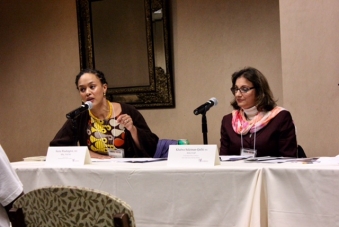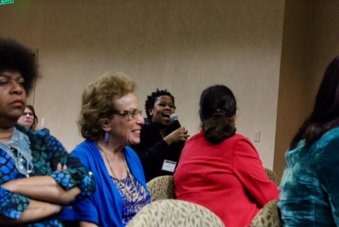
By Rachel Williams
Photo, left: “Here at The Nile Sisters we’re really trying to address health disparities and improve access to care for our refugee and immigrant population,” said Susan H. the health advocacy coordinator for The Nile Sisters Initiative.
February 1, 2017 (San Diego) -- The Nile Sisters Initiative hosted a panel at The Joan B. Kroc Institute for Peace and Justice on female genital cutting (FGC), also known as female circumcision. Refugees and immigrants face several physical and mental health complications after undergoing the procedure in their home countries.
FGC refers to a range of procedures, such as the partial or total removal of the clitoris, cutting and stitching together the inner folds of the vulva, known as the labia minora, or burning, scraping and piercing the genitalia tissue for non-medical reasons.
FGC is a traditional practice with cultural and social implications. Girls between 5 and 14 years old are at the greatest risk of FGC. Female elders carry out the tradition as a rite of passage for girls into adulthood.
 “Are there alternatives to this rite of passage? People have suggested replacing that ceremony with another ceremony. Potentially doing smaller, or symbolic cutting. Potentially replacing with another rite of passage. Really trying to acknowledge you can’t just in a vacuum remove something that has played an important cultural role in many societies,” Dr. Sierra Washington (right), Medical Director of Planned Parenthood of the Pacific Southwest, said.
“Are there alternatives to this rite of passage? People have suggested replacing that ceremony with another ceremony. Potentially doing smaller, or symbolic cutting. Potentially replacing with another rite of passage. Really trying to acknowledge you can’t just in a vacuum remove something that has played an important cultural role in many societies,” Dr. Sierra Washington (right), Medical Director of Planned Parenthood of the Pacific Southwest, said.
FGC causes severe immediate and long-term health consequences for women and their offspring. It creates urination problems, chronic infections and the formation of cysts. Women are at a greater risk of experiencing complications during childbirth, such as prolonged labor, postpartum hemorrhage and obstetric fistula.
 “If you aren’t familiar, in these countries there’s a person that’s designated as the cutter in the village, and it’s at that time when the child reaches those ages. They just gather them up, and take them to wherever they do this. My clients have told me their mother didn’t even know it was happening on that day that it was their aunt that set it up or their grandmother,” Elizabeth Lopez (left), Attorney and Founder of the Southern California Immigration Project, said.
“If you aren’t familiar, in these countries there’s a person that’s designated as the cutter in the village, and it’s at that time when the child reaches those ages. They just gather them up, and take them to wherever they do this. My clients have told me their mother didn’t even know it was happening on that day that it was their aunt that set it up or their grandmother,” Elizabeth Lopez (left), Attorney and Founder of the Southern California Immigration Project, said.
It’s estimated that more than 200 million girls and women have undergone FGC, while 3 million are currently at risk, according to The World Health Organization. More than 90-percent of the female population is circumcised in Somalia, Guinea, Djibouti and Sierra Leone. While in Egypt, Mali, Sudan and Eritrea, the prevalence rate is over 80-percent. FGC is most common in sub-Saharan Africa, but it’s practiced in the Middle East and Southeast Asia.
“But be very careful about how we can address it. Be very trauma informed, and try not to offend anybody who can be from Africa and the Middle East being circumcised. We have to be very careful because it’s an issue. If it’s 1-percent; if it’s 0. 7-percent, it’s an issue. We cannot go backward, but we can move forward. What are you gonna do for your daughter? What do you want your daughter to be?” Dilkwaz Ahmed, Executive Director of License to Freedom, said.
Roughly 506,795 women and girls are at risk of undergoing FGC in the U.S., or may have already experienced it. This is double the estimation in 2000, which reflects the U.S.’s rapid immigration increase, according to the Population Reference Bureau.
 “I like the term female circumcision because it’s a term more respectful to the culture, who has this practice for years. Really the act itself is done out of love to the children and the right of passage, so technically it was not done with the idea in mind to mutilate children, or to hurt their children,” Dr. Khalwa Suleiman-Qafti (right), Assistant Medical Director of Pediatrics of Family Health Centers of San Diego, said.
“I like the term female circumcision because it’s a term more respectful to the culture, who has this practice for years. Really the act itself is done out of love to the children and the right of passage, so technically it was not done with the idea in mind to mutilate children, or to hurt their children,” Dr. Khalwa Suleiman-Qafti (right), Assistant Medical Director of Pediatrics of Family Health Centers of San Diego, said.
Its estimated that 57,000 women and girls are at risk of FGC in California, according to The Nile Sisters Development Initiative (NSDI). Approximately 30,000 individuals from Somalia, South Sudan, Sudan, Ethiopia and Eritrea reside in the community of City Heights.
“Empower the men with education, with knowledge, and the practice will go away, because it’s very deep. It’s associated with how much money the father gets when their daughter gets married, the cows that come along with it, fairness in the community, how high up you go in the government, so it’s very complex. It cannot be solved over night,” Richard Makau, panel attendee, said.
It’s illegal in the U.S. to perform, assist or attempt to take a girl outside of the U.S. for FGC, known as vacation cutting. Illinois and Tennessee have enacted legislation mandating healthcare providers, school personnel, social workers and law enforcement to report FGC. Underreporting is a major barrier to ensuring access to sexual and reproductive services.
 “I feel like I see it from country to country to country. It’s always let’s go after women's' bodies, and what they can and can’t do, and get other women on board, so it’s not just the men telling us what we can do, we have other women telling us what we should do with our own bodies,” Nekose Wills (left), panel attendee, said.
“I feel like I see it from country to country to country. It’s always let’s go after women's' bodies, and what they can and can’t do, and get other women on board, so it’s not just the men telling us what we can do, we have other women telling us what we should do with our own bodies,” Nekose Wills (left), panel attendee, said.
Global migration has increased the risk of FGC in foreign countries, and in the U.S. The Nile Sisters Development Initiative (NSDI) provides a safe space in San Diego for refugees and immigrant women to overcome social and economic barriers. They recognize FGC as a worldwide health concern needing a coordinated, systematic response.












Recent comments